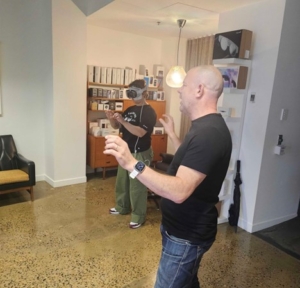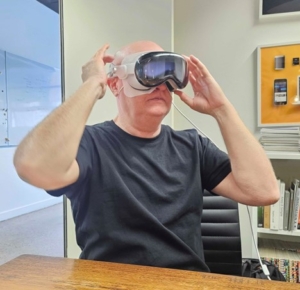Tess Hutley, Russ Weakley, and Dom Parker (me!) from Intopia visited Oliver Weidlich at Contxtual recently. Oliver had one of the first Apple Vision Pros (AVP) in Australia and we were eager to have a play with this much anticipated device. We went into this demonstration from an accessibility point of view to understand how this device could assist users with disabilities.
According to Apple, “the Apple Vision Pro is Apple’s first spatial computer. It seamlessly blends digital content with your physical space using revolutionary technology”. Apple has designed their own operating system called VisionOS to make this possible. It is a wearable headset device that allows users to complete tasks, watch movies, engage with apps, and customise their virtual space. It also features Apple’s first 3D camera, allowing users to capture spatial photos and videos.
Dom’s Experience
The Apple Vision Pro is immersive and futuristic. It’s made from a combination of metal, plastic, flex glass, and has a fabric strap. You tighten the strap by turning a dial, ensuring the headset sits securely on your face. I did notice that after a while, the pressure started to cause some wear fatigue and I felt my face throb. However, the fabric strap is very soft, which helps with comfort.
One of the standout features is the specific MagSafe charger designed for the Apple Vision Pro. Its unique shape and roundness make it distinguishable and easy to differentiate from other Apple chargers. The battery pack is also worth mentioning. It’s made of metal and is incredibly light, so you barely feel it in your pocket. Apple advertises the battery life to be about 2 hours, but Oliver has been getting 2.5 to 3 hours out of it.
As someone with a vision impairment in one eye, I was initially hesitant about using the Apple Vision Pro. However, I was impressed by the accuracy of the eye-tracking during calibration. I closed my impaired right eye and could still focus on the dots with only my left eye. The pinch gestures are intuitive and became muscle memory within about 10 minutes. However, I do wonder how someone with fine motor skill challenges would fare with the pinch method.
For home/app selection, you simply look at the desired app and it enlarges slightly to indicate selection. Personally, I wish there was an additional colour change to make the selection more obvious, especially in varying lighting conditions.
The accessibility menu is accessible by triple-clicking the digital crown. There, you can find options for one-eye use, zoom functions, colour changes, and voiceover. I’d love to see more features like the option to highlight selected apps with a brighter or more colourful glow, and an audio cue aside from the voiceover.
The Apple Vision Pro has its own app store with Vision Pro-supported apps, which is more limited than the regular App Store. Some iPad apps, like Slack, are available. The showcased features are incredibly impressive – viewing a human heart, a F1 racecar, immersive dinosaurs, and moon renderings. The detail is extraordinary, down to the scales on the dinosaur and craters on the moon.
You can upload your photos and panoramas, but they can only be immersive if taken with an iPhone 15 or the Apple Vision Pro itself. Netflix and YouTube aren’t native apps and can only be viewed in a Safari browser. However, Disney Plus offers an immersive landscape for their content.
The Apple Vision Pro will likely boost the AR device market, offering something unique beyond just another gaming headset. With a projected retail price between $6,000-$7,000 AUD, it’s an expensive developer kit for now. It targets those with disposable income who want the latest tech.
Tess’s Experience
I have severe motion sickness and vertigo, so I was wary about trying the Vision Pro. Surprisingly, I felt fine using it. Unlike my bad experiences with other devices like the Oculus Rift, the Apple Vision Pro blurs the content when you move your head quickly. This feature prevents your eyes from trying to process too much information at once, which helps prevent motion sickness. The visual distance is set at 1.3 metres, which likely also helps.
Learning to operate the Apple Vision Pro required a combination of looking and pinching. It took some time and effort to get used to this coordination, but it started feeling more natural within 10 minutes. However, I struggled with differentiating short versus long pinches. It would be interesting to see how people with motor-based disabilities handle this.
The headset feels solid and can become fatiguing due to the weight on your face. While it’s okay to sit with, it’s not the most comfortable for walking around. The eye-gaze software worked well for me most of the time, but its sensitivity made me wary of where I was looking since the focus constantly shifts in response.
Overall Impressions
The Apple Vision Pro is a significant step forward in AR technology, but it’s not without its challenges. From a design perspective, the combination of metal, plastic, and flex glass makes it durable and stylish, though it can become uncomfortable over time. The unique MagSafe charger and lightweight battery pack are practical and user-friendly.
The device’s immersive capabilities are impressive, bringing detailed renderings of complex objects like human hearts, racecars, dinosaurs, and the moon to life. However, its current app ecosystem is limited, with major streaming services like Netflix and YouTube only accessible through Safari.
One of the key benefits of the Apple Vision Pro is its potential to assist people with disabilities. The eye-tracking feature, for instance, could help individuals with limited mobility navigate the device without needing to use their hands. The zoom functions and colour adjustments can aid users with vision impairments, making content more accessible. The ability to customise the virtual environment can also provide a more comfortable and tailored experience for users with various needs. However, there’s room for improvement, particularly in making app selections more visible and adding more auditory feedback options.
I should highlight, we only had a short amount of time testing the Apple Vision Pro. There are many stories out there of people loving the AVP. Some examples of the great user cases of the AVP are described in this ‘I Know What the Apple Vision Pro Is For’ article
From Intopia’s perspective, the Apple Vision Pro is an exciting and innovative device that showcases the potential of augmented reality. It’s clear that Apple has put a lot of thought into the design and functionality of the AVP. There are still areas that could be improved, particularly in terms of accessibility and comfort. As developers continue to create new and exciting content for the AVP, it will be interesting to see how this technology evolves and becomes more accessible to everyone.
Ultimately, the Apple Vision Pro is set to enhance the AR landscape significantly. Its price point will make it accessible primarily to tech enthusiasts with disposable income, but the potential for it to aid individuals with disabilities is a promising development. This device represents a significant step forward in making technology more inclusive and accessible for all users.



